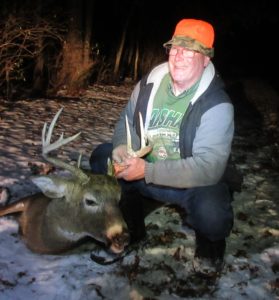A Whitetail Buck Worth the Wait
By Glen Wunderlich
Charter Member Professional Outdoor Media Association (POMA)
Our first snowfall of the season had obliged this seasoned deer hunter with a contrasting layer of ground cover every hunter desires. The sun had set and primetime had arrived. That last half hour of light, when the whitetails move into their feeding areas, is as predictable as the setting sun itself. The travel routes and timetables were well established, as I waited with high expectations.
A doe and two fawns appeared across the field but were not interested in pausing for a nutritional clover salad. They simply strolled out of view in short order but had me on high alert when two more does marched by without stopping. The high winds and snow cover were not inviting them to feed, whereby I would be blessed with living decoys.
With ten minutes of daylight remaining, a whitetail with sizeable headgear had gotten the memo and began a 200-yard trek on course with the others. I watched and waited, as it closed the gap moving steadily at a right angle from me. Like the others this evening, it never altered its mission to cross the entire field directly, and, as a result, I was compelled to pass on the moving target.
The very next morning, I took a position overlooking swampland on one side and the same clover field in the opposite direction. My thought was to intercept a buck – and, hopefully that big boy – after it had had enough fun during the cover of darkness and would be returning to the seclusion of the tall timber on that same travel route I knew so well.
Whether it was the same buck seen the evening before, I’ll never know, but a good buck was spotted along the predictable path. I had measured all the scattered trees in the field and knew that the range was between 130 to 140 yards.
I was thrust into thinking afield. Would this qualify as a legitimate attempt – one that would meet my strict guidelines for touching off a fire-breathing blast from my rifle in .450 Bushmaster caliber? The question I asked myself was not if I could do it 9 of 10 times but could I do it on my first try? Try is the operative word and there is no “try” in my book. Accordingly, my doubting permitted the beast to walk.
Even though I possess credentials as a Department of the Army marksman, I had never attempted a 140-yard shot at a six-inch moving target in low-light conditions. Therefore, I passed on a questionable opportunity – an opportunity to miss and thus educate, or worse yet, injure, maim, or cripple a majestic and revered animal.
With this buck’s travel pattern and timetable understood, I would get closer to its path for the afternoon session. I hid in a crude blind fashioned from a hollowed-out hill of dirt slightly above ground level. The bright sun did its disappearing act below the treetops at 5pm with my appointment pending. A few minutes later a doe burst on-scene and the reason became obvious: A large buck was chasing it.
The peacefulness turned frantic, as the doe sped off with the buck trailing. However, for whatever reason, the big boy did a U-turn and posed broadside for a moment at 105 yards. Without hesitation, I focused on an aiming point that would guarantee an ethical kill, while not destroying a large portion of meat. It meant the animal would run upon the bullet’s impact and I was fine with that result.
I saw the strike of the 250-grain Barnes copper bullet through the low-power, variable Zeiss scope and it was “fait accompli”. But, that fact didn’t prevent me from adding to the excitement with a phone call to my friend, Joe Reynolds, who had offered the services of his tracking dog.
Even though the trail was obvious in the snow, the dog’s nose is what drove him to the prize in a bit over eight minutes: a huge 10-point buck!

10-Point Buck, Shiawassee County, Michigan
It seems the more dues I pay afield, the luckier I get.
YouTube video of the tracking chore here: Glen Wunderlich Takes Huge Michigan Whitetail Buck with .450 Bushmaster – YouTube






